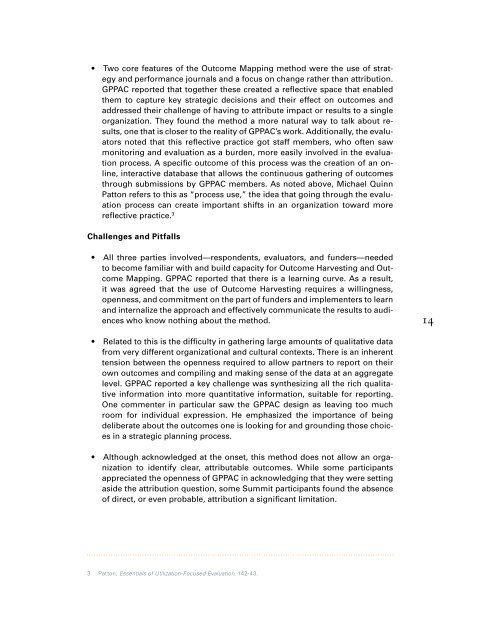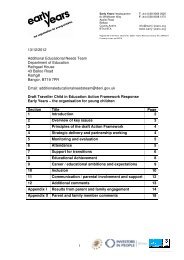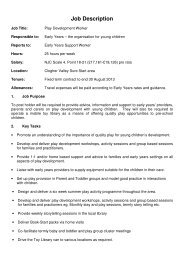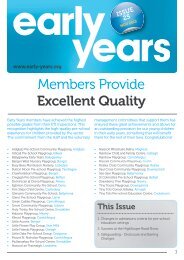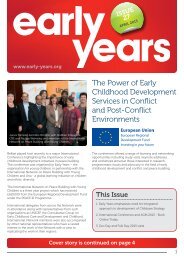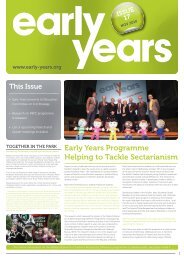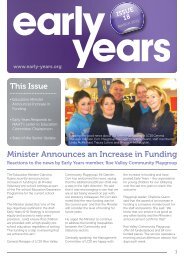Learning from Nine Examples of Peacebuilding Evaluation
Learning from Nine Examples of Peacebuilding Evaluation
Learning from Nine Examples of Peacebuilding Evaluation
You also want an ePaper? Increase the reach of your titles
YUMPU automatically turns print PDFs into web optimized ePapers that Google loves.
• Two core features <strong>of</strong> the Outcome Mapping method were the use <strong>of</strong> strategy<br />
and performance journals and a focus on change rather than attribution.<br />
GPPAC reported that together these created a reflective space that enabled<br />
them to capture key strategic decisions and their effect on outcomes and<br />
addressed their challenge <strong>of</strong> having to attribute impact or results to a single<br />
organization. They found the method a more natural way to talk about results,<br />
one that is closer to the reality <strong>of</strong> GPPAC’s work. Additionally, the evaluators<br />
noted that this reflective practice got staff members, who <strong>of</strong>ten saw<br />
monitoring and evaluation as a burden, more easily involved in the evaluation<br />
process. A specific outcome <strong>of</strong> this process was the creation <strong>of</strong> an online,<br />
interactive database that allows the continuous gathering <strong>of</strong> outcomes<br />
through submissions by GPPAC members. As noted above, Michael Quinn<br />
Patton refers to this as “process use,” the idea that going through the evaluation<br />
process can create important shifts in an organization toward more<br />
reflective practice. 3<br />
Challenges and Pitfalls<br />
• All three parties involved—respondents, evaluators, and funders—needed<br />
to become familiar with and build capacity for Outcome Harvesting and Outcome<br />
Mapping. GPPAC reported that there is a learning curve. As a result,<br />
it was agreed that the use <strong>of</strong> Outcome Harvesting requires a willingness,<br />
openness, and commitment on the part <strong>of</strong> funders and implementers to learn<br />
and internalize the approach and effectively communicate the results to audiences<br />
who know nothing about the method.<br />
14<br />
• Related to this is the difficulty in gathering large amounts <strong>of</strong> qualitative data<br />
<strong>from</strong> very different organizational and cultural contexts. There is an inherent<br />
tension between the openness required to allow partners to report on their<br />
own outcomes and compiling and making sense <strong>of</strong> the data at an aggregate<br />
level. GPPAC reported a key challenge was synthesizing all the rich qualitative<br />
information into more quantitative information, suitable for reporting.<br />
One commenter in particular saw the GPPAC design as leaving too much<br />
room for individual expression. He emphasized the importance <strong>of</strong> being<br />
deliberate about the outcomes one is looking for and grounding those choices<br />
in a strategic planning process.<br />
• Although acknowledged at the onset, this method does not allow an organization<br />
to identify clear, attributable outcomes. While some participants<br />
appreciated the openness <strong>of</strong> GPPAC in acknowledging that they were setting<br />
aside the attribution question, some Summit participants found the absence<br />
<strong>of</strong> direct, or even probable, attribution a significant limitation.<br />
3 Patton, Essentials <strong>of</strong> Utilization-Focused <strong>Evaluation</strong>, 142-43.


